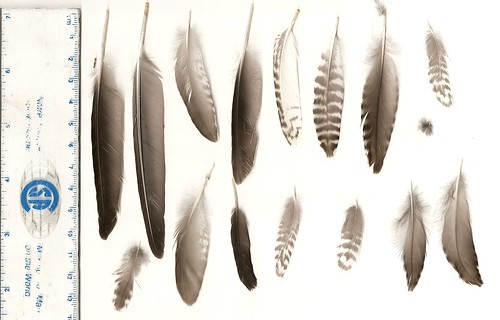tags: Short-billed Dowitcher, Limnodromus griseus, birds, mystery bird, bird ID quiz
[Mystery bird] Probable Short-billed Dowitcher, Limnodromus griseus, remains were fairly close to a busy industrial road northern Alberta (roughly 300 km northeast of Edmonton) Canada. [short of microscopic examination of these feathers or DNA analysis, this bird will probably never be definitively identified, sorry]
Image: Marcel Gahbauer, August 2009 [larger view].
Scanned, not photographed.
Please name at least one field mark that supports your identification.
The collector writes;
The location of this bird is northern Alberta (roughly 300 km northeast of Edmonton), and the habitat was black spruce forest with some jack pine. The feathers were found fairly close to a busy industrial road, so I would think it's not a particularly shy species - though I suppose it could have been killed elsewhere and brought there by its predator to be plucked. I've included a ruler (both inches and cm) for scale with the feathers to help.


Looks very like a dowitcher to me.
long-billed or short-billed?
If it is a dowitcher, and if feather 6 in the upper row is a central rectrix, then I'd say Long-billed--the pale bands are narrower than the black bands, and appear to be brown rather than white.
But now I'm very, very far out on a very, very slender limb.
Just a thought -- mid-August seems rather early for a Long-billed Dowitcher to be in complete non-breeding plumage, as this bird appears to be. (I can't see any brown or red tones in any of the feathers.) There does seem to be some wear in the primaries, but that could be from whatever killed it.
The only alternative I'm able to offer would be a Greater Yellowlegs, and I don't really think that's right either.
Seems I never give enough consideration to shorebirds in such cases - thanks for the ideas!
In this case I don't know the landscape well, but aside from a bit of water in the ditch and some very murky water in the bottom of a deep pit, I didn't see any wetlands nearby. However, whatever killed it may of course have taken it some distance before plucking.
I should note that the date of the encounter was actually July 30; by then Long-billed Dowitchers had already been moving through the area for a couple of weeks, and I suspect Greater Yellowlegs too, but I haven't heard of more than a handful of Short-billed Dowitcher sightings.
Tail feather 6 in the upper row very closely matches the first central tail feather of the Short-billed Dowitcher illustrated on page 328 in Shorebirds of the Pacific Northwest (Paulson 1993). Also, in my experience the pale bars on Long-billed are much narrower than on feather 6. The location of the feathers (Alberta) is in the breeding range of Short-billed Dowitcher of the subspecies hendersoni, which has pale bars similar in width to this feather. Short-billeds (nominate griseus) in Eastern Canada have narrower pale bars thus closely approaching Long-billed (Godfrey 1986, Birds of Canada).
The unmarked grey primaries are consistent with a male Spruce Grouse.
The black and white barred feathers ending in a white tip(last one in the top row and 4th and 5th in the bottom row)look consistent with underparts(flanks?) and the brown/black barred look like back or rump area.
Spruce Grouse have much differently shaped primary feathers, which are very noticeably curved. I checked with Michel Gosselin of the Canadian Museum of Nature who agreed that they are not grouse feathers.
I don't think there's any doubt that this is a dowitcher. I can't recall whether there are wing chord differences between the two North American species, but if so, perhaps the measurement of feather two in the upper row, an outer primary from the left wing, could help point to one or the other.